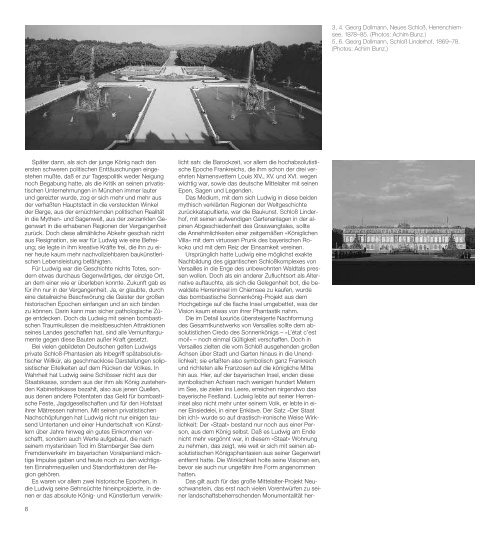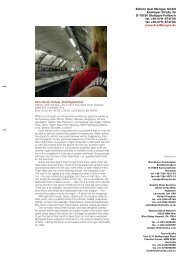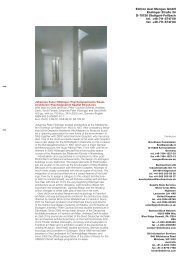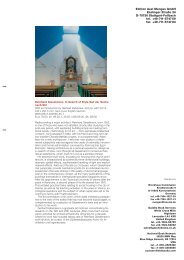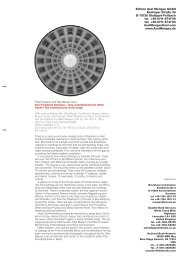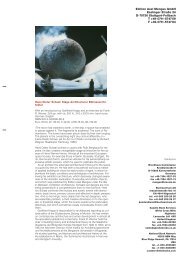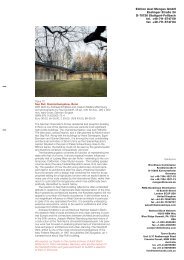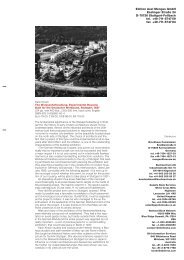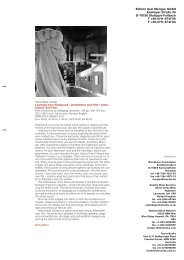Opus 33. Neuschwanstein, e - Edition Axel Menges
Opus 33. Neuschwanstein, e - Edition Axel Menges
Opus 33. Neuschwanstein, e - Edition Axel Menges
Sie wollen auch ein ePaper? Erhöhen Sie die Reichweite Ihrer Titel.
YUMPU macht aus Druck-PDFs automatisch weboptimierte ePaper, die Google liebt.
Später dann, als sich der junge König nach den<br />
ersten schweren politischen Enttäuschungen eingestehen<br />
mußte, daß er zur Tagespolitik weder Neigung<br />
noch Begabung hatte, als die Kritik an seinen privatistischen<br />
Unternehmungen in München immer lauter<br />
und gereizter wurde, zog er sich mehr und mehr aus<br />
der verhaßten Hauptstadt in die versteckten Winkel<br />
der Berge, aus der ernüchternden politischen Realität<br />
in die Mythen- und Sagenwelt, aus der zerzankten Gegenwart<br />
in die erhabenen Regionen der Vergangenheit<br />
zurück. Doch diese allmähliche Abkehr geschah nicht<br />
aus Resignation, sie war für Ludwig wie eine Befreiung;<br />
sie legte in ihm kreative Kräfte frei, die ihn zu einer<br />
heute kaum mehr nachvollziehbaren baukünstlerischen<br />
Lebensleistung befähigten.<br />
Für Ludwig war die Geschichte nichts Totes, sondern<br />
etwas durchaus Gegenwärtiges, der einzige Ort,<br />
an dem einer wie er überleben konnte. Zukunft gab es<br />
für ihn nur in der Vergangenheit. Ja, er glaubte, durch<br />
eine detailreiche Beschwörung die Geister der großen<br />
historischen Epochen einfangen und an sich binden<br />
zu können. Darin kann man sicher pathologische Züge<br />
entdecken. Doch da Ludwig mit seinen bombastischen<br />
Traumkulissen die meistbesuchten Attraktionen<br />
seines Landes geschaffen hat, sind alle Vernunftargumente<br />
gegen diese Bauten außer Kraft gesetzt.<br />
Bei vielen gebildeten Deutschen gelten Ludwigs<br />
private Schloß-Phantasien als Inbegriff spätabsolutistischer<br />
Willkür, als geschmacklose Darstellungen solipsistischer<br />
Eitelkeiten auf dem Rücken der Volkes. In<br />
Wahrheit hat Ludwig seine Schlösser nicht aus der<br />
Staatskasse, sondern aus der ihm als König zustehenden<br />
Kabinettskasse bezahlt, also aus jenen Quellen,<br />
aus denen andere Potentaten das Geld für bombastische<br />
Feste, Jagdgesellschaften und für den Hofstaat<br />
ihrer Mätressen nahmen. Mit seinen privatistischen<br />
Nachschöpfungen hat Ludwig nicht nur einigen tausend<br />
Untertanen und einer Hundertschaft von Künstlern<br />
über Jahre hinweg ein gutes Einkommen verschafft,<br />
sondern auch Werte aufgebaut, die nach<br />
seinem mysteriösen Tod im Starnberger See dem<br />
Fremdenverkehr im bayerischen Voralpenland mächtige<br />
Impulse gaben und heute noch zu den wichtigsten<br />
Einnahmequellen und Standortfaktoren der Region<br />
gehören.<br />
Es waren vor allem zwei historische Epochen, in<br />
die Ludwig seine Sehnsüchte hineinprojizierte, in denen<br />
er das absolute König- und Künstlertum verwirk-<br />
8<br />
licht sah: die Barockzeit, vor allem die hochabsolutistische<br />
Epoche Frankreichs, die ihm schon der drei verehrten<br />
Namensvettern Louis XIV., XV. und XVI. wegen<br />
wichtig war, sowie das deutsche Mittelalter mit seinen<br />
Epen, Sagen und Legenden.<br />
Das Medium, mit dem sich Ludwig in diese beiden<br />
mythisch verklärten Regionen der Weltgeschichte<br />
zurückkatapultierte, war die Baukunst. Schloß Linderhof,<br />
mit seinen aufwendigen Gartenanlagen in der alpinen<br />
Abgeschiedenheit des Graswangtales, sollte<br />
die Annehmlichkeiten einer zeitgemäßen »Königlichen<br />
Villa« mit dem virtuosen Prunk des bayerischen Rokoko<br />
und mit dem Reiz der Einsamkeit vereinen.<br />
Ursprünglich hatte Ludwig eine möglichst exakte<br />
Nachbildung des gigantischen Schloßkomplexes von<br />
Versailles in die Enge des unbewohnten Waldtals pressen<br />
wollen. Doch als ein anderer Zufluchtsort als Alternative<br />
auftauchte, als sich die Gelegenheit bot, die bewaldete<br />
Herreninsel im Chiemsee zu kaufen, wurde<br />
das bombastische Sonnenkönig-Projekt aus dem<br />
Hochgebirge auf die flache Insel umgebettet, was der<br />
Vision kaum etwas von ihrer Phantastik nahm.<br />
Die im Detail luxuriös übersteigerte Nachformung<br />
des Gesamtkunstwerks von Versailles sollte dem absolutistichen<br />
Credo des Sonnenkönigs – »L’état c’est<br />
moi!« – noch einmal Gültigkeit verschaffen. Doch in<br />
Versailles zielten die vom Schloß ausgehenden großen<br />
Achsen über Stadt und Garten hinaus in die Unendlichkeit;<br />
sie erfaßten also symbolisch ganz Frankreich<br />
und richteten alle Franzosen auf die königliche Mitte<br />
hin aus. Hier, auf der bayerischen Insel, enden diese<br />
symbolischen Achsen nach wenigen hundert Metern<br />
im See, sie zielen ins Leere, erreichen nirgendwo das<br />
bayerische Festland. Ludwig lebte auf seiner Herreninsel<br />
also nicht mehr unter seinem Volk, er lebte in einer<br />
Einsiedelei, in einer Enklave. Der Satz »Der Staat<br />
bin ich!« wurde so auf drastisch-ironische Weise Wirklichkeit:<br />
Der »Staat« bestand nur noch aus einer Person,<br />
aus dem König selbst. Daß es Ludwig am Ende<br />
nicht mehr vergönnt war, in diesem »Staat« Wohnung<br />
zu nehmen, das zeigt, wie weit er sich mit seinen absolutistischen<br />
Königsphantasien aus seiner Gegenwart<br />
entfernt hatte. Die Wirklichkeit holte seine Visionen ein,<br />
bevor sie auch nur ungefähr ihre Form angenommen<br />
hatten.<br />
Das gilt auch für das große Mittelalter-Projekt <strong>Neuschwanstein</strong>,<br />
das erst nach vielen Vorentwürfen zu seiner<br />
landschaftsbeherrschenden Monumentalität her-<br />
3, 4. Georg Dollmann, Neues Schloß, Herrenchiemsee,<br />
1878–85. (Photos: Achim Bunz.)<br />
5, 6. Georg Dollmann, Schloß Linderhof, 1869–78.<br />
(Photos: Achim Bunz.)<br />
the finest available, sacred and unapproachable,<br />
a worthy temple for the divine friend through whom<br />
alone every blessing was bestowed upon the world ...<br />
This castle will be more beautiful and comfortable in<br />
every respect than the lower castle of Hohenschwangau,<br />
which is desecrated year after year by my mother’s<br />
prosaic nature; the profaned gods will seek vengeance,<br />
and come dwell with Us on the steep summit,<br />
fanned by celestial breezes.«<br />
The New Castle – the name »<strong>Neuschwanstein</strong>« was<br />
not used until after Ludwig’s death – was thus to be<br />
the holy place for the friendship cult with Richard Wagner,<br />
a temple in which the myths and heroes from<br />
Wagner’s music dramas would not only come to life<br />
for the duration of a performance, but would always<br />
be present as images, inviting the friends to a life together<br />
outside contemporary existence, beyond base<br />
everyday reality, and high above all political obligations.<br />
In certain important details, the old castle of Hohenschwangau<br />
served as a model for this ambitious<br />
vision. For example, the castle of <strong>Neuschwanstein</strong> also<br />
contains extensive historical paintings, like those<br />
which completely cover all the walls of both residential<br />
floors at Hohenschwangau. In both castles, a pronounced<br />
»horror vacui« seems to have been operative.<br />
Yet the intentions behind both cycles of paintings are<br />
radically different. Maximilian surrounded himself primarily<br />
with historical figures and events that were related<br />
to Schwangau. He wanted the breath of history<br />
to waft through the rooms of his castle. But this Romantic<br />
nostalgia for the Middle Ages already had a<br />
distinct Biedermeier cast. For Maximilian, who during<br />
his later reign promoted the sciences and supported<br />
experimentation with new technology and modern<br />
styles, the excursions into a glorified idyllic past were<br />
edifying; through the slick historical paintings he made<br />
sure of the past, flooded by something like elation. But<br />
it would never have occurred to him to identify with the<br />
»olden days« or even to wish he could return to them.<br />
Even as a child at Hohenschwangau, Ludwig had<br />
identified to the point of self-surrender with the Swan<br />
Knight, the subject of the paintings in the central hall.<br />
The knowledge he gained about the newly revived<br />
medieval legends in Wagner’s musical dramas, and a<br />
personal encounter with the Swan Knight in a production<br />
of Lohengrin by the Munich Court Opera in 1861<br />
were momentous experiences for the young dreamer<br />
of myths.<br />
Later, when the young king was forced to admit,<br />
after his first serious political disappointments, that<br />
he had no inclination or talent for day-to-day politics,<br />
when, in Munich, the voices criticizing his privatistic<br />
undertakings became increasingly loud and irritated,<br />
he withdrew more and more from the hated capital to<br />
the hidden recesses of the mountains – from sobering<br />
political reality to the world of myths and legends, from<br />
the bickering present to the lofty regions of the past.<br />
Yet this gradual withdrawal was not caused by resignation:<br />
it was a kind of liberation for Ludwig. It freed<br />
creative forces within him which enabled him to carry<br />
out architectural feats that could scarcely be repeated<br />
today.<br />
For Ludwig, history was not dead, but very current:<br />
the only place where someone like him could survive.<br />
The only future that existed for him was in the past.<br />
Indeed, he believed that by conjuring up the spirits of<br />
the great historical epochs in rich detail, he could cap-<br />
ture them and link them to his own person.No doubt it<br />
is easy to discover pathological traits in this endeavor.<br />
Yet all rational arguments against these construction<br />
projects are invalidated, for with his bombastic dream<br />
backdrops Ludwig created the most popular tourist<br />
attractions in his country.<br />
Many cultured Germans consider Ludwig’s private<br />
castle fantasies to be the epitome of late absolutistic<br />
despotism, tasteless representations of solipsistic vanity,<br />
the cost of which had to be borne by his people. In<br />
reality, Ludwig paid for his castle not out of the public<br />
purse but from the cabinet treasury to which he was<br />
entitled as the king – in other words, from the same<br />
sources as those from which other princes obtained<br />
money for extravagant banquets, hunting parties, and<br />
the households of their mistresses. With his privatistic<br />
re-creations, Ludwig not only provided years of a good<br />
income for several thousand subjects and a hundred<br />
or so artists, but also created objects of value which<br />
after his mysterious death in the Starnberger See gave<br />
significant impetus to tourism in the foothills of the Bavarian<br />
Alps, and which until the present day have been<br />
one of the region’s most important sources of income<br />
and its locational factors.<br />
There were primarily two historical epochs into<br />
which Ludwig projected his longings, periods in which<br />
he saw absolute royal power and artistry turned into<br />
reality: the Baroque period, especially the peak of absolutism<br />
in France – important to him if only because<br />
of his three venerated namesakes, Louis XIV, XV, and<br />
XVI – and the German Middle Ages, with their epics,<br />
myths, and legends.<br />
The medium by means of which Ludwig catapulted<br />
himself back into these two mythically transfigured regions<br />
of world history was architecture. Schloß Linderhof<br />
with its lavish park in the Alpine seclusion of the<br />
Graswangtal was meant to combine the conveniences<br />
of an up-to-date »royal villa« with the virtuoso splendour<br />
of Bavarian Rococo and the charm of solitude.<br />
Originally Ludwig had planned to squeeze a recreation<br />
of the gigantic castle complex of Versailles,<br />
rendered as exactly as possible, into the narrow uninhabited<br />
forest valley. But when another refuge appeared<br />
as an alternative, when the opportunity arose<br />
to buy the wooded Herreninsel in the Chiemsee, the<br />
bombastic project of the Sun King was transferred to<br />
the flat island, which scarcely detracted from its fantasy<br />
character.<br />
The re-creation of the Gesamtkunstwerk of Versailles,<br />
luxuriously exaggerated in its detail, was meant<br />
to validate, once again, the absolutist credo of the Sun<br />
King – »L’état c’est moi!« However, in Versailles, the<br />
great axes that radiate from the castle were aimed beyond<br />
the town and the park out into infinite space;<br />
thus they symbolically included all of France and orientated<br />
all French people toward the royal centre. Here<br />
on the Bavarian island, these symbolic axes end in<br />
the lake after a few hundred metres, they are aimed<br />
at empty space, and do not reach the Bavarian mainland<br />
at all. On his Herreninsel, Ludwig thus no longer<br />
lived among his people, but in a hermitage, an enclave.<br />
The statement »I am the state!« was thus realized<br />
in a drastically ironic way: The »state« now consisted<br />
of only one person – the king himself. The fact<br />
that Ludwig was in the end no longer granted the privilege<br />
of taking up his residence in this »state« shows<br />
the extent to which he had distanced himself from<br />
9


